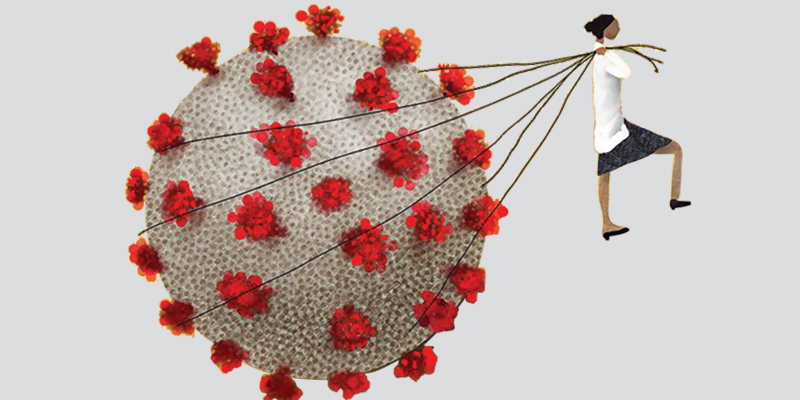MB Stories
Unprecedented times create unprecedented opportunities

Despite a downturn caused by COVID-19 disruption, the sector’s resilience and emerging cultural importance will see its value continue to soar in the coming years.
The initial economic shock of COVID-19 presented an opportunity for medical device companies. For many industry insiders, the main impact of the pandemic on the MedTech sector has been the acceleration of trends that were already well underway in the preceding years.
Confronted with the advance of this major pandemic, MedTech has stepped up to the clinical front line and played a critical role in the attempts to defuse the crisis. From mass-producing ventilators, sterilizing equipment, face masks, and other protective personal equipment, to inventing and distributing the rapidly expanding range of diagnostic tests now reaching the market, the industry achieved an incredible amount in 2020. MedTech’s work has saved lives, allowed medical facilities to keep running, enabled patients to be treated in hospitals or at home, and overall made it possible for normal operations to be maintained, while simultaneously also helping health systems, governments and the general public wage a global health battle on a scale not previously seen this century.
In many ways, COVID-19 changed everything for the medical device market.
After three straight years of record investment, the pandemic hit the sector’s coffers hard. The first half of 2020 saw global revenues decline by 3.2 percent; life sciences M&A activity totaled USD 159 billion in 2020 — a plunge to nearly half of the 2019 total of USD 306 billion, representing one of the lowest levels observed since 2014; and the number of PE deals fell to 3096 in 2020, compared with 3600 in 2019, says EY in a recent study.
However, the external events of the pandemic have caused a wholesale shift toward business models that allow MedTech organizations to properly capitalize on existing trends within the sector.
Thanks to these long-term trends, the industry has met the demand for specialist equipment and remained resilient in the face of adversity. Indeed, despite some segments receiving financial blows, other segments such as diagnostics have surged in value and become a major target for investment. And though revenue for the medical device industry has been falling since the start of the pandemic, the sector is expected to slowly recover in the second half of 2021.
Opportunities from the crisis-Where Indian MedTech is heading and beyond
The COVID-19 crisis will help illuminate the way for a brighter future for the industry, by demonstrating the need to futureproof business models, strengthen supply chains and ecosystem relationships, and accelerate the progress of digital technology and data. The pandemic has shown that industry can accelerate progress in all of these areas and that by delivering innovation through the use of data and digital technology, stakeholders will secure the future of this industry, and community.
This evolution is not solely a result of the COVID-19 crisis; on the contrary, the underlying drivers for MedTech’s transformation have been increasingly evident in recent years. The rise of connected devices is drawing MedTech into the Internet of Things and opening up new opportunities for data-driven improvements in clinical outcomes; growing cost constraints on healthcare systems; establishing the impetus for providers to assist MedTech in reshaping its business models and ecosystem relationships; and seeing patient-consumers’ increasing demands for a more customer-centered healthcare experience.
These drivers of change were all recognized by the MedTech industry prior to 2020. However, COVID-19 has increased the urgency for MedTech to respond to these drivers and to accelerate its transformation. The challenge of the COVID-19 pandemic has highlighted the room for improvement in MedTech’s business models, supply chain systems, regulatory relationships, and deployment of digital and data tools. The industry now has the chance to address these limitations and place itself in a better position to thrive in the next and the beyond.
Teleconsultation. It has always been a quick and simple way to reach the doctor. Most individuals can recount consulting their doctor on a phone, or using a network or video link like Facetime, WhatsApp or Zoom at some point. It has been prevalent since a while now and is not a new concept in India.
2020 and thereon has witnessed a massive expansion of teleconsulting as doctors and patients are restricted to interact in person. Most patients have refrained from getting in-person doctor consultations for acute ailments due to the lockdown and risk of infection. They mostly relied on self-medication and self-diagnostic apps. Some even took medical consultations with general practitioners or family doctors on calls during the first few months of the pandemic. However, with the pandemic extending beyond a few months, patients were forced to explore new channels for reliable acute care. Patients with chronic ailments, such as diabetes, are identified as a high-risk group, resulting in an increase in adoption of digital channels for disease management and control for such chronic diseases.

Healthcare providers, such as hospitals and e-pharmacies, have integrated teleconsultation platforms and scaled up their existing digital offerings. Teleconsultation and e-pharmacy platforms have showed a steep growth in adoption by both, doctors as well as patients. For example, Fortis Healthcare has witnessed a shift in the outpatient department (OPD) consultation with 10 percent of the pre COVID-19 consultations moving to the teleconsultation platform.
The pandemic has highlighted the need to build a simplified and holistic teleconsultation platform encompassing all key stakeholders. With the current levels of adoption by the patient– consumers and doctors, along with emerging teleconsultation platforms, India has commenced its teleconsultation journey.
Virtual care. There is need for a paradigm shift in the healthcare delivery system in India. The World Health Organization prescribed doctor–patient ratio in India does not suffice as a metric to describe the readiness and robustness of the healthcare system. The parity of healthcare, in terms of infrastructure and quality of care, across metros, Tier-I and Tier-II cities and beyond and rural areas needs to be achieved. About 75 percent of India’s population living outside urban cities has access to only 31.5 percent hospitals and 16 percent hospital beds. Such disparity has compelled India to neglect preventive, rehabilitative and public health measures. This, among other aspects related to the pandemic, has pushed the country into the current state marked by limited access to healthcare in a mass health exigency. Teleconsultation shows the promise to bridge this gap in the future by removing many infrastructural challenges and reducing the time taken by a patient in getting consultations.
Lack of mobility has led to change in consumer behavior, with digital consumption becoming an integral part of it. A holistic teleconsultation platform may become the fabric of healthcare in India and may evolve to integrate with the broader healthcare system.
The Indian healthcare consumer looks for dual benefit of price and convenience. Online health-tech businesses are trying to refine their business models around this value proposition. It is the promise of delivery that has enabled online healthcare models to receive steady funding since their inception in the early 2000s. With COVID-19 further highlighting this need in healthcare delivery, e-pharmacies and health-tech firms are attracting investors interest. The industry may see further refinement and simplification of business models and may eventually lead to consolidation and growth.
Digital healthcare ecosystem in India. Clinical pathway is a patient–consumer journey from preventive wellbeing management, primary care, secondary to tertiary and quaternary care. Each step may include additional pathways such as diagnostics, medicines and follow-up. Historically, there has not been much integration between each step. Moreover, there has been disparity in the quality of care as well. To bridge this gap, the then government used digital technologies and launched a virtual healthcare initiative, Social Endeavour for Health and Telemedicine (SEHAT) in 2015. It aimed to connect 60,000 health service centers pan-India to provide quality healthcare service.
E-pharmacies, and hospitals have also tried to digitize parts of their value chain. Some steps were fulfilled online, while others were completed offline. While the idea to address the disparity in quality healthcare through digital is pertinent, the progress was made in silos and hence the required scale was never achieved. The COVID-19 pandemic has brought out the need for integrating all the steps in the clinical pathway digitally. Hence, the value lies in creating an ecosystem that can integrating all the stakeholders from doctors, caregivers, diagnostic labs and pharmacies to patients and insurance companies to enable an end-to-end customer journey.
Global market dynamics
Technological advances are revolutionizing the medical device industry, not only increasing the number of connected medical devices available to market but strengthening their role in healthcare. The global medical devices market in 2020 was valued at USD 456.9 billion, which is an increase at a compounded annual growth rate (CAGR) of 4.4 percent since 2015. Despite an expected decline of 3.2 percent in 2020, it is expected to rebound in 2021 with a 6.1 percent CAGR and reach USD 603.5 billion in 2023. The top opportunities in the medical devices market segmented by type of device will arise in the IVD market segment, expected to gain USD 23.4 billion of global annual sales by 2023. The hospitals and clinics segment is expected to gain USD 130.0 billion of global annual sales by 2023. Public healthcare expenditure segment is expected to gain USD 81.7 billion of global annual sales by 2023.

Developments in wireless technology, smaller devices, and computing power are changing the landscape of the interconnectedness of devices. The data collected, analyzed, and shared from medical devices with healthcare organizations is allowing for better patient outcomes, lowering of costs, and presenting an additional revenue source. Properly integrating and disseminating patient information will only strengthen future growth in MedTech.
Some major trends attributed to technological advances, presenting new opportunities as well as challenges for medical device companies include:
Internet of Medical Things (IoMT) to modernize healthcare. Significant innovations in new technologies such as smart sensors, smart devices, and other lightweight communication devices are driving medical devices that generate data into care pathways, creating alliances with IoMT systems. These advancements that help aid in the monitoring of biomedical signals and the diagnoses of diseases without human intervention are aiding healthcare organizations to improve patient outcomes, lower costs, and improve efficiency. The role of MedTech is now even more important, serving as a value-based partner rather than just a developer and supplier of devices. The IoMT market is expected to grow USD 285.5 billion by 2029, which is a compound CAGR of 28 percent.
Medical device companies are looking at their business models and identifying ways to integrate IoMT in order to serve as partners for payors, healthcare providers, and patients. By harnessing the data and making it meaningful to healthcare providers, a new value-based program can be monetized.
Device connectivity as another source of revenue. MedTech is discovering an opportunity to create another revenue stream with data. Software as a medical device (SaMD) is transforming healthcare, empowering patients to be better informed and involved in their own health conditions. Patients with chronic conditions that require monitoring can obtain the data and share it with other healthcare professionals, allowing them to better manage their health. Those that are willing to share data can help improve their treatments and help medical device companies enhance their products. Currently 40 percent of patients are willing to share personal data for medical research, while 35 percent are willing to share it with medical device manufacturers according to a survey. This presents an opportunity for medical device companies to monetize the sharing of data, where patients own the data and proprietary tools are then used to distribute them to interested parties.
Robotics. The advancements in robotic surgery has led to a huge demand for minimally invasive robotic surgery (MIRS) both from physicians and patients, creating a double-digit growth rate within the last five years. The surgical robot market is expected to grow from USD 5.5 billion to over USD 24 billion by 2025, doubling the current 1 million MIRS procedures worldwide.
Strengthen cybersecurity. The threat of cybersecurity is now at the forefront for medical devices, with numerous exchanges of information and accessibility between healthcare providers, manufacturers, and suppliers. As technology advances, so has the sophistication of cyberattacks. Medical device security can be implemented not only during the conceptual and developmental stages but extended throughout the product’s lifecycle in order to prevent cyberattacks. Though larger companies claim they are better prepared to handle cybersecurity issues, smaller companies need to react quickly and work together to minimize any harm to the flow of information.
The FDA recognizes that medical devices share the responsibility of cybersecurity threat across the ecosystem but specifically holds manufacturers primarily responsible for managing cybersecurity risks within their products. A security ‘playbook’ was created last year to assist healthcare delivery organizations to respond to threats of cybersecurity. There have not been any cases to date on attacks on medical devices. Medical device companies should be prepared to provide documentation of processes implemented to the FDA showing that cybersecurity risks are being managed.
Supply chains
As healthcare becomes more virtualized and moves toward an anytime, anywhere model, MedTech companies need to ensure their supply chains are ready to meet this change. However, a number of challenges stand in the way.
Pre-COVID, the industry faced the problems of inefficiencies associated with supply intermediaries and inflexible legacy systems, as well as a lack of transparency for regulators and companies alike. These were already hotly-contested topics prior to the pandemic.
Arguably the biggest challenges, however, are political in nature. The last decade has seen a widespread backlash against globalization (and, by association, against globalized supply chains) from nationalist politicians and their support bases. COVID has made travel restrictions a reality, but so too have seismic political events such as Brexit.
Changes to trade agreements have far-reaching implications for the industry, most notably around the location of manufacturing plants, which are typically concentrated in low-cost geographies. Will such restrictions lead to the onshoring of manufacturing to safeguard supply bases? Only time will tell.
Thus far, the MedTech sector has not sought to localize supply. Instead, it has responded to supply chain disruption by forging mutual partnerships between device manufacturers and component part manufacturers.
Regulation
COVID-19 has transformed regulation in the MedTech sector. Since February 2020, the FDA has authorized over 250 emergency use authorizations (EUAs), while the EU chose to defer its Medical Device Regulation (initially slated for May 2020) by a year. These moves are symptomatic of a wider industry trend that has seen the loosening of stringent regulatory conventions across the globe.
Of course, this relative leniency was borne out of the need to quickly and effectively get new devices to market as part of the fightback against COVID. As the virus retreats, the frequency of EUAs will likely decrease. But a precedent has been set.
During the pandemic, regulators and MedTech organizations have been receptive to one another and come together to meet the urgent demand for vital equipment (including IVD and other tests, as well as PPE and ventilators). Beyond COVID, this sense of collaboration and collaboration is set to flourish further.
Outlook
Ongoing advancements in medical technology and the growth of information sharing through IoT-enabled devices are causing a sea change in healthcare.
Just as changes to working patterns and consumer behaviors have facilitated the need for remote technologies, so too has the evolution of the relationship between patients and physicians. As the COVID-19 pandemic demonstrated, the medical device market is more than ready to meet this demand for user-friendly diagnostics and monitoring devices.
The global medical devices industry expected to reach a valuation of USD 612.7 billion by 2025 is growing at 5.4 percent CAGR. Thanks to growing consumer demand and technological innovation, the industry is expected to see high growth in product areas such as wearable healthtech, robotics nanotechnology, and extended reality devices. Artificial intelligence is also facilitating the creation of increasingly sophisticated data-driven algorithms, such as autonomous diagnostics.
Despite recent setbacks, opportunities abound for medical device companies of all sizes.











